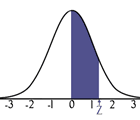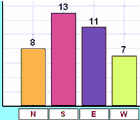| | | | | | Using and Handling Data

STATISTICS IS FUN!
By way of a recap on statistics, we are just going to take a general look at what we mean by statistics and statistical data. It is a very simple introduction. So, let us start with some definitions:
Data We talk about data in statistics:
- Data (singular ‘datum’) are things known or assumed as a basis for inference.
- Or, to put it more simply: 'Pieces of information that are collected during a study.' (Burns & Grove 2005:733)
|
Statistics Statistics is concerned with the systematic collection of numerical data and its interpretation.
Burns & Grove (2005:752) refer to a statistic as simply 'a numerical value obtained from a sample that is used to estimate the parameters of a population.'
The word ‘statistics’ is used to refer to:
- Numerical facts, such as the number of people living in a particular town.
- The study of ways of collecting and interpreting these facts.
|
It can be argued that figures are not facts in themselves. It is only when they are interpreted that they become relevant to discussions and decisions. So statistics are there to inform our discussions - they are a means to an end, not an end in themselves.
Statistics can be divided into two types:
1. Descriptive statistics:
Includes the presentation of data in tables and diagrams, as well as calculating percentages, averages, measures of dispersion and correlation, in order to show the relevant features of the data and to reduce it to manageable proportions.
In other words, descriptive statistics involves the summary of the statistics in such a way that the researcher can organise the data contained within these statistics in ways that allow them to give meaning and insight to them.
2. Inductive/inferential statistics:
Involves methods of inferring properties of a population on the basis of known sample results.
It is also known as inductive reasoning.
These methods are based directly on probability theory.
Now to look at some basic, simple, and common statistical calculations, that we use a lot in statistics.
Average
- This is a measure of central tendency and of location.
- It summarises a group of figures, and smoothes out any abnormalities.
- It provides a mental picture of the distribution that it represents.
- It can provide knowledge about the whole distribution.
- You will know that it is often used loosely in daily conversation.
- However, it can conceal important facts.
|
Arithmetic mean
This is the average to which most people refer when they use the word 'average'.
It can be defined as the sum of the items divided by the number of these items
arithmetic mean = total value of items divided by the total number of items - or (to use symbols):
Arithmetic mean = Σx divided by n:
where Σ = the sum of x (value of items) and n is the number of items |
For example, if we were to look at the ages of child branch student nurses (a group of 21 students) when they commence at the university, we might find that there are:
- 11 aged 18
- 5 aged 19
- 2 aged 20
- 1 aged 25
- 1 aged 33
- 1 aged 51
Then, according to the box above, to get the arithmetic mean of the group age, we would add all the ages together and then divide by 21.
To doOkay, do that, and work out what the arithmetic mean of the group age is.
|
Answer
So we can see that the average age of this group of child branch students on commencement at the university is 21 years.
| Reflection Can we now say that the age of child branch students on commencing university everywhere is 21 years? |
Answer
You should also have noticed that our average of 21 years does conceal some important facts.
- The great majority of these students are aged 18 to 20 years when they commence the university, and there are just 3 students out of the 21 who are older than 21 years.
- Therefore, it does not give a truly accurate picture of the group, let alone allowing us to generalise (after all, other universities may have a ban on anyone starting the child branch course who are over 25 years of age).
However, we do have a couple of calculations that we can do with these figures that can give us perhaps a more realistic average.
The first of these is the Median.
Median The median is the value of the middle item of a distribution which is set out in order.
Formula
n + 1 ÷ 2
(n+1 divided by 2, where n = number of items)
|
Therefore, let us return to the ages of this cohort of child branch student nurses (a group of 21 students) when they commence at the university, namely:
- 11 aged 18
- 5 aged 19
- 2 aged 20
- 1 aged 25
- 1 aged 33
- 1 aged 51
| To do Use the box above about 'median' calculations, and work out the median of the group. |
Answer
Does the median age give a more accurate picture of the group as a whole?
I think you would agree that the answer has to be 'yes'. because 18 years is closer to the age of the great majority of the group.
However, it still does not identify the anomaly that is the ages of the older students.
We have yet another type of average to look at - the Mode.
Mode The mode is the numerical value of a score that occurs with the greatest frequency in a distribution.
However, it does not necessarily indicate the centre of the set of data.
(Burns & Grove 2005:743) |
| To doUsing the ages of our group, work out the modal age of the group. |
Answer
In this case, the mode is the same as the median (but both are different from the mean), but this is not always the case.
Consequently, you need to look closely at any statistics, because they are not always what they seem to be!
Finally, in this little section, let us look at range.
Range The range is an everyday method of describing the dispersion or spread of data.
It can be defined as the highest value in a distribution minus the lowest.
|
Reflection Often range is given along with one of either mean, median or mode.
Why do you think this is so? |
| |
|
|





Tidak ada komentar:
Posting Komentar